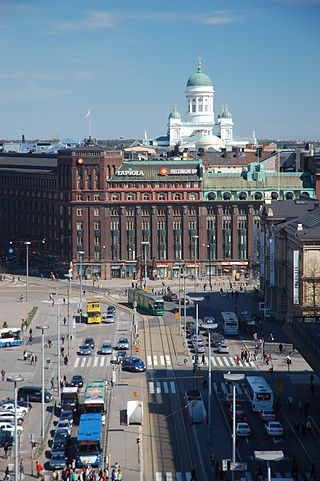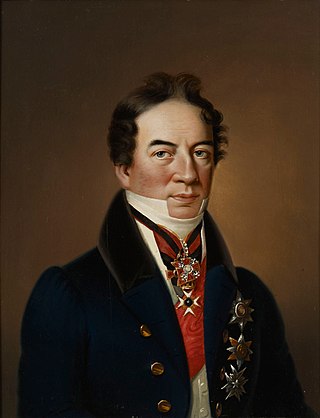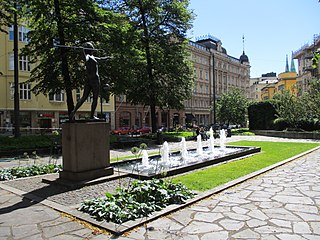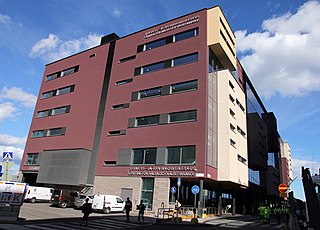
Hakaniemi is an unofficial district of Helsinki, the Finnish capital. It covers most of the neighbourhood of Siltasaari in the district of Kallio. Hakaniemi is located at the sea shore and is separated from the city centre by the Siltavuorensalmi strait and from the district of Linjat by the street Hämeentie. Historically, Hakaniemi was often associated with the working class and workers' associations. However, the cost of living has risen considerably in recent years and is now on par with that of the rest of central Helsinki.

Punavuori is a neighbourhood in the center of Helsinki, the capital of Finland. The name Punavuori refers to red cliffs located between Sepänkatu and Punavuorenkatu. They were still visible in the 19th century, nowadays they are covered with buildings and pavement. Punavuori was traditionally a working-class neighbourhood, today it is known as a bohemian district popular among artists, students and hipsters. It is one of the most densely populated areas in Finland.

Pasila is a part of Helsinki, Finland, that is both a central-northern neighbourhood and district, bordering the areas of Alppila to the south, the Central Park (Keskuspuisto) to the west, and Vallila to the east.

Aleksanterinkatu is a street in Kluuvi, the commercial centre of Helsinki, Finland. In the city plan by Carl Ludvig Engel, it was the Decumanus Maximus, the main east–west street in the city, crossing the Cardo, Unioninkatu (Union Street) at the corner of the Senate Square.

Kluuvi is the commercial centre of Helsinki, Finland, and a neighbourhood in the Vironniemi district of Helsinki. The Helsinki Central railway station, Hotel Kämp and Hotel Arthur, the Helsinki main post office, the Stockmann and Sokos department stores, the Kluuvi shopping centre and the main offices of Finnish banks are located in Kluuvi. Kluuvi includes the central campus of the University of Helsinki, the Ateneum art museum, and the movie theatres Maxim, Kinopalatsi and Bristol. The northeastern part of Kluuvi, which includes the Kaisaniemi park, is commonly called Kaisaniemi, but it is not the official name of any neighbourhood in Helsinki.

Count Robert Henrik Rehbinder served as the Secretary of State for the Grand Duchy of Finland between 1811 and 1841. One of the highest officials in the Grand Duchy, he played a significant part in establishing the autonomous role of Finland at the Diet of Porvoo in 1809.

Fredrikinkatu is a street in Helsinki, Finland that starts from Viiskulma in the district of Punavuori and continues north by the western side of Kamppi Center until it reaches Lutherinkatu and the Temppeliaukio Church in Etu-Töölö.

Munkkivuori is a quarter of the Munkkiniemi neighbourhood in Helsinki. The buildings and the plan of site are typical of the late 1950s. Most of the residential buildings in Munkkivuori are within a loop formed by Ulvilantie ring road. The automotive traffic to the residential buildings is routed along Ulvilantie whereas Raumantie no through road terminating in the center of the Ulvilantie loop provides access to public services and limits the through-traffic in residential areas. A designed network of crushed stone walkways provides easy accessibility around Munkkivuori for cyclists, pedestrians and other non-automotive traffic.

The Old Student House is the former student house of the Student Union of the University of Helsinki, located in central Helsinki, Finland, near the crossing of Aleksanterinkatu and Mannerheimintie.

Itä-Pasila (Finnish), Östra Böle (Swedish) is a neighborhood in the Pasila subdivision of Helsinki, Finland.

Bulevardi is a boulevard in Helsinki, Finland. It starts at Erottaja and ends at Hietalahdentori. The majority of the boulevard is located in the western part of the Kamppi neighborhood and a small part of Punavuori. Restaurants, cafes, and art galleries line the street. The Alexander Theatre and Sinebrychoff Museum of Art are located on Bulevardi.

Viiskulma is a well known intersection of five streets in Helsinki at the boundary of the Punavuori and Ullanlinna neighbourhoods. The street Fredrikinkatu is one of the oldest and major traffic arteries of Helsinki's inner city.
Roba is a Finnish police drama television series. The series follows the daily life of Helsinki Police Department's uniformed police unit located on the Pieni Roobertinkatu ("Roba") street. The series stars Kari Hietalahti, Aku Hirviniemi, Aarni Kivinen, Leena Pöysti, Riku Nieminen, and Tiina Lymi. Many of its episodes are directed by Joona Tena and Aleksi Mäkelä.

Vaasanpuistikko, meaning "Vaasa park", is an area in Helsinki, Finland, surrounded by the streets of Helsinginkatu, Vaasanpolku and Pengerpolku around the western entrance to the Sörnäinen metro station, near the so-called Sörnäinen curve. Even though Vaasanpuistikko is located in the neighbourhood of Alppiharju, it is commonly thought of as a part of Kallio. Vaasanpuistikko is connected with Vaasankatu.

The Sinebrychoff Park, colloquially referred to as the "Koff Park", is a park in Punavuori, Helsinki, Finland, near Hietalahti. The park was named after the Sinebrychoff brewery, which had its premises next to the park from 1819 to 1992 and to whose lands the park used to belong, and the Sinebrychoff family that owned both. In addition to the Old Church Park and Kaivopuisto, the park is among the most popular parks in Helsinki.

The Eliel Square is a square on the west side of the Helsinki Central Station in the heart of Helsinki, Finland. It is named after the railway station designer Eliel Saarinen. The square is for the most part the departure and arrival platforms for regional buses.

Kolmikulma, also known as the Diana Park, is a small, rectangular triangular-shaped park located in the Kaartinkaupunki district in the city center of Helsinki, Finland. It is limited by the Yrjönkatu, Uudenmaankatu and Erottajankatu streets. The park was renovated in 2006 and 2007.

Autotalo is a business building in Kamppi, Helsinki, Finland, built in 1958. It is located near the Kamppi metro station in a lot bordered by the streets of Salomonkatu to the south, Fredrikinkatu to the east and Runeberginkatu to the west. The address of the building is Salomonkatu 17. The Autotalo building consists of two 12-floor towers, and it comprises the southern half of its city block. The name "Autotalo" is sometimes used to refer to the entire block, also consisting of the two separate high-rise buildings at the northern edge of the block, built at the same time as the Autotalo building.

The Kalasatama Health Station is a service centre for health and social services in the Kalasatama neighbourhood of the Sörnäinen district in Helsinki, Finland. It is located about 200 metres to the east-northeast of the Kalasatama metro station.

Kaivokatu is a short street in central Helsinki, Finland. It runs past the Central Station and station square, connecting Mannerheimintie in the west with Mikonkatu in the east. Towards its eastern end is located the Ateneum art museum of the Finnish National Gallery.



















